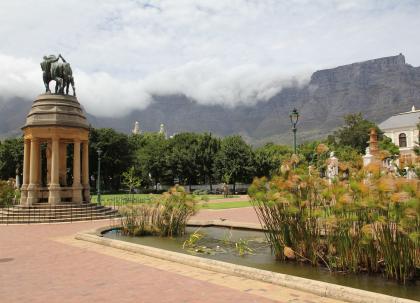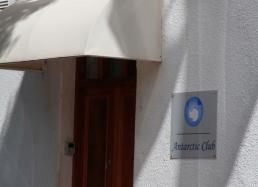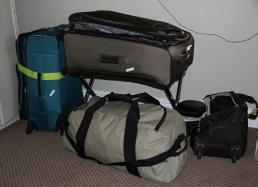1. The First Leg of the Journey
After a long flight, I’ve arrived in Cape Town, South Africa—the first stop in my journey to reach Antarctica. And what a beautiful city it is! Gorgeous scenery, fantastic architecture, and from almost every vantage point you can see the impressive Table Mountain, a national park that features a two-mile-wide plateau.
During my stay, temperatures have ranged from 50°F (10°C) at night to 84°F (29°C) during the day. While most Capetonians complain that this is too hot for them, for me the hot weather is very welcome, since I’ll soon be heading south to the below-freezing temperatures of Queen Maud Land.
There’s not much time for sightseeing now, too much to do to finish up last-minute preparations for the trip: writing reports, buying more supplies and medicine, organizing the luggage, attending a pre-flight briefing, and communicating with the team members (many of whom are already on the ice) to create more detailed fieldwork plans, which can vary based on the weather and ice conditions.
After last week’s storm at Novo Station, which caused flight delays of several days for our Lake Untersee team, the forecast for this week predicts good weather and fair skies—we’re currently cleared to depart Cape Town tonight as scheduled.
Luckily, we don’t have to wear our polar clothes until we reach the Antarctic Circle. I was told to pack everything in a separate bag so that I can change on the plane. I have no idea how this will work, as planes are usually cramped, and even removing a jacket is a challenge, but I am sure that the staff have worked out a routine procedure for this.
A day before the flight, we had our pre-flight briefing at the Antarctic Club (see Photo #1 below) of the contractor ALCI (Antarctic Logistics Centre International) for the Russian Antarctic Expedition (RAE). Our expedition is part of the RAE, who have partnered with The Von Braun Center for Science & Innovation, Inc. (VCSI) to take care of all our permits and other administrative work.
At the briefing, we received all the necessary information for the flight and destination. We’ll fly in an Ilyushin-76 aircraft, which is widely used as a cargo transport—but for ALCI, the plane has been reconfigured to hold passengers in the front half of the aircraft and cargo in the rear.
In my next blog, I’ll report on the flight experience and arrival in Antarctica, where we’ll land on an ice runway at Novo airport. One of the many interesting things we learned in our briefing is what happens when litter is left on the runway. Of course, littering is prohibited to keep the environment as pristine as possible, but in Antarctica, it’s crucial to maintain a spotless runway. A dark piece of garbage can heat up in the sun and melt a hole in the ice, which makes for a dangerous landing!
We were comforted to learn, however, that in the remote and unlikely event of an emergency, ALCI is able to perform search-and-rescue operations within 24 hours. The key is to stay warm for 24 hours! And obviously, the best plan is to avoid getting oneself in an emergency situation to begin with—extra caution, common sense, and adhering to all safety precautions are key here.
All together, there are about 50 of us flying into Novo Station, and from there, we’ll be distributed by feeder flights or land travel to the various research outposts in Queen Maud Land. I’ll travel with the ten Indian polar staff members that I had the pleasure of meeting at the pre-flight briefing. Many of these gentlemen will be staying in Antarctica for 14-15 months and will be responsible for keeping Maitri (the Indian research station) running throughout the year.
Cape Town is much cooler today and extremely windy, with gusts of up to 31 mph (50 km/h.) And while Chicago is called the “windy city,” Cape Town could easily adopt this name, too. Even in my short stay here, I can definitely confirm the truth of the saying, “You can experience four seasons in one day at Cape Town.”
They just picked up my bags for the airport (see Photo #2 below) and everything is set for departure to Antarctica tonight at 11 p.m. A few hours are left before heading to the airport, enough time to get a hearty meal!
More soon,
Philipp R. Heck, Ph.D.
The Robert A. Pritzker Assistant Curator of Meteoritics and Polar Studies
A Tawani International Expedition





